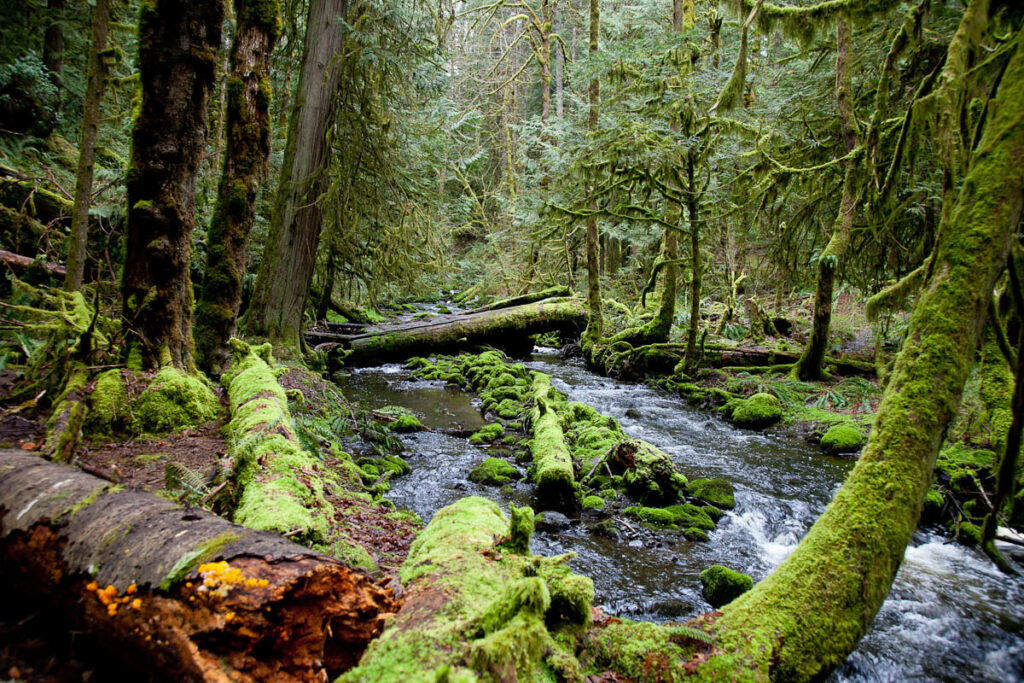Maintenance of hydrologic function and fish habitat
Highlights
- Old growth forests contribute to salmon and trout survival because they provide a continuous source of energy to streams from leaves which supports stream food webs; they contribute large, fallen trees to streams and rivers that create channel structure (e.g., pools) and instream cover; they ameliorate temperature extremes and flood peaks in streams and rivers; and they hold together soil and rocks, controlling sediment input and stabilizing stream channels.
- Logging and road building disturbances, whether within the riparian zoneA riparian zone is a transitional zone between a river or stream and drier uplands. More or in the broader watershed area, can result in detrimental impacts to stream hydrology, stream ecology, and fish habitat via increased erosion, fine sediment inputs and more landslides.
Logging and road building disturbances, whether within the riparian zoneA riparian zone is a transitional zone between a river or stream and drier uplands. More or in the broader watershed area, can result in detrimental impacts to stream hydrology, stream ecology, and fish habitat, as summarized below based on Hicks (2002)Hicks, B. J. 2002. Gravel galore: Impacts of clear-cut logging on salmon and their habitats. In Harvey, B. and M. MacDuffee (eds.). Ghost Runs: The future of wild salmon on the north and central coasts of British Columbia. Raincoast Conservation Society. Victoria, BC. More and, where noted, Franklin et al. (1981)Franklin, J.F., Cromack, K. Jr., Denison, W., McKee, A., Maser, C., Sedell, J., Swanson, F., Juday, G. 1981. Ecological characteristics of old-growth Douglas-fir forests. USDA Forest Service, Pacific Northwest Forest and Range Experiment Station, Gen. Tech. Rep. PNW-118. More.
Stream Ecology
- it provides a continuous source of energy to streams from leaves which supports stream food webs;
- it contributes large, fallen trees to streams and rivers that create channel structure and instream cover;
- it ameliorates temperature extremes and flood peaks in streams and rivers; and
- it holds together the soil and rocks, controlling sediment input and stabilizing stream channels.
Forest litter is the main energy base for small to medium-size streams in old growth forests, with large streams depending more on algae than litter for their energy base (Franklin et al., 1981Franklin, J.F., Cromack, K. Jr., Denison, W., McKee, A., Maser, C., Sedell, J., Swanson, F., Juday, G. 1981. Ecological characteristics of old-growth Douglas-fir forests. USDA Forest Service, Pacific Northwest Forest and Range Experiment Station, Gen. Tech. Rep. PNW-118. More). Riparian vegetation provides leaf inputs to the stream, which begins a food chain. Debris may be fully utilized by the biotic communityA biotic community is a group of organisms that live together and interact with each other within an environment or habitat. Together, the biotic community and the physical landscape (abiotic factors) make up an ecosystem. More within a stream reach or may be exported downstream to feed larger streams with a partially prepared food resource. In old growth forest streams, 60-70% of the annual organic inputs are retained long enough to be biologically used by stream organisms (Franklin et al., 1981Franklin, J.F., Cromack, K. Jr., Denison, W., McKee, A., Maser, C., Sedell, J., Swanson, F., Juday, G. 1981. Ecological characteristics of old-growth Douglas-fir forests. USDA Forest Service, Pacific Northwest Forest and Range Experiment Station, Gen. Tech. Rep. PNW-118. More). Large dams of woody debris resulting from falling trees sieve and deposit fine organic matter, allowing time for microbial colonization and eventual consumption of the material by aquatic insects and other invertebrates. These aquatic invertebrates form the food source for juvenile salmon and other stream vertebrates, including trout, sticklebacks, sculpins, tailed frogs, and salamanders. Terrestrial invertebrates falling from the riparian vegetation are also an important food source for fish. Mammals and birds then feed on the fish. This food chain is disrupted if riparian vegetation is removed.
Fish Habitat
Large wood in streams creates pools and beds of trapped gravel and fine sediments that are important habitat for numerous stream and stream-margin organisms (Franklin et al., 1981Franklin, J.F., Cromack, K. Jr., Denison, W., McKee, A., Maser, C., Sedell, J., Swanson, F., Juday, G. 1981. Ecological characteristics of old-growth Douglas-fir forests. USDA Forest Service, Pacific Northwest Forest and Range Experiment Station, Gen. Tech. Rep. PNW-118. More) including habitat for overwinter survival of fish such as Coho salmon. The amount of large wood in streams declines rapidly with the removal of adjacent old-growth forest, and even the largest wood from second growth forest is smaller, more mobile, and decays faster than wood from old forests. Without large wood, sediments and beds are less stable and less organic matter is stored. Logs are an important source of energy and woody debris is the major source of the nitrogen supply of a stream.

